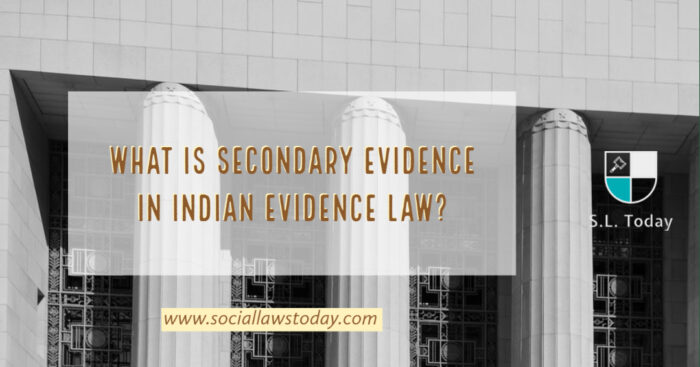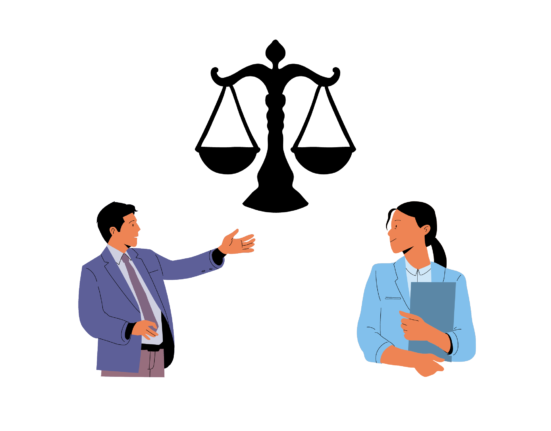Secondary evidence
Simran Veer, 13 October,2020
The Indian Evidence Law basically deals with documentary evidence which is further classified as Primary evidence and Secondary evidence. Primary evidence, on the one hand, deals with the documents which are produced in the court. Whereas, Secondary evidence means an inferior type of evidence, which means that even after producing the secondary evidence one needs to produce primary evidence in order to fill in the gaps. Such evidence can be presented in the absence of the primary evidence. According to section 63 of the Indian Evidence Act, 1872 secondary evidence includes certified copies, copies of the original documents made by the mechanical process, counterparts of documents, oral accounts of the contents of a document given by someone who has seen the document himself.
Under the Indian Evidence Act, 1872 the documentary evidences which are directly produced before the court are known as the ‘Primary Evidence’ and these evidences are categorised as the best evidence. The best evidence rule means by proving a document is the document itself. But there arise certain cases where the original document is lost or destroyed. In such cases, the Evidence Act tenders the copies of original documents as the Secondary Evidence. It is defined under section 63 of the Indian Evidence Act, 1872 and is permitted to be produced before the court in the form of summary of the original documents.
Further, in this article we will analyse the concept of secondary evidence including all the sections which it covers in the Indian Evidence Act, along with the relevant case laws.
DIFFERENCE BETWEEN PRIMARY EVIDENCE & SECONDARY EVIDENCE
Indian Evidence Law identifies ‘primary evidence’ as the topmost class of evidence. Primary evidence is an original document which is to be presented before the court of law for the purpose of inspection and it is admissible without any prior notice. Primary evidence is given the priority to be presented before the secondary evidence. Secondary evidence on the other hand, are to be presented only in the absence of the primary evidence i.e., original document. In such cases, the reason as to why the original document cannot be presented is to be explained before the court of law. Secondary evidence is the copy of the original documents and are acceptable only in the exceptional case where the primary evidence is not available.
Below is the tabular representation of the differences between primary evidence & secondary evidence-
| SNO. | PRIMARY EVIDENCE | SECONDARY EVIDENCE |
| 1. | Primary Evidence is the Original document presented before the Court of Law for inspection. | Secondary Evidence is the copy of the Original document which is presented before the Court of law in the absence of the Original document. |
| 2. | It is considered as the main and authentic source of evidence. | It is considered as the alternative source of evidence. |
| 3. | It is defined under Section 62 of the Indian Evidence Act, 1872. | It is defined under Section 63 of the Indian Evidence Act, 1872. |
| 4. | Primary Evidence is the best evidence. | It is not the best evidence but are acceptable only in certain exceptional cases. |
| 5. | Submitting Primary evidence is the general rule. | Submitting secondary evidence is an exception to the general rule. |
| 6. | No notice is required before giving primary evidence. | A notice is required to be given before giving secondary evidence. |
| 7. | The value of Primary evidence is highest. | The value of secondary evidence is not equal to that of primary evidence. |
CONCEPT OF SECONDARY EVIDENCE
Section 63 of the Indian Evidence act defines ‘secondary evidence’, where clause (1) to clause (3) deals with the copies of the document. This particular section is exhaustive when it comes to the types of secondary evidence admissible under the Act. However, to make the it admissible, it is necessary to provide a reason for the non-production of the original document. For e.g. Tenant file Xerox copy of money receipt in his plea without giving proper reason and Xerox is authentic then it will be not admissible. The different sections of the Act deal with the different types of the secondary evidence.
What are secondary evidences? The secondary evidence are the copies made from the original ones or the copies compared to the original copies. In the case where the copy of a certified copy of a document has not been compared with the original, therefore will not be admissible as the secondary copy of the original.
When it comes to electronic evidence, although these are considered as secondary evidences but the provision dealing with the secondary evidences never used the term ‘electronic evidence or content of electronic documents.’ The reason for omitting the word ‘electronic evidence’ is that the legislative clearly intends that the applicability of section 61 to 65 of the evidence act does not extend to the electronic records as it overrides the provision of section 65-B of the Indian Evidence Act. This section exclusively deals with the electronic evidence and the manner in which they are admissible.
JUDICIAL PRONOUNCEMENT
Arjun Khotkar vs Kailash Kushanrao Gorantyal
In this case the bench of J. R.F. Nariman, J. S. Ravindra Bhat and J. V. Ramasubramanian held that, section 65B (4) of the Indian Evidence Act, 1872 requires a certificate for the admissibility of evidence by way of electronic record and is considered as the condition precedent. The same was held in the case of Anvar P.V. vs P.K. Basheer and was criticised by the division bench in the case of Shafhi Mohammad vs State of Himachal Pradesh, the Court in this case further clarified that the rule under Section 65B (4) is not necessary if the original document is produced in the court.
Clarification on Anvar P.V. Case
“…. If an electronic record as such is used as primary evidence under Section 62 of the Evidence Act, the same is admissible in evidence without compliance with the condition in Section 65-B of the Evidence Act.”
The last sentence in Anvar P.V. Case is read as follows-
“…. If an electronic record as such is used as primary evidence under section 62 of the Evidence Act….”
The court clarified the above-mentioned sentences and said that, Section 65-B (4) is not necessary if the original document is produced before the court. This can be proved by the laptop/computer owner where the original information was stored and was operated by its owner. In cases where it becomes impossible to bring such a system or network before the Court, then the electronic evidence can be produced in accordance with Section 65B (1) along with the requisite certificate.
The Court also stated that, Section 65B applies to the cases where certificate as to the admission of the secondary evidence is to be procured by the person who relies upon an electronic record. And, also states that such certificate must accompany the electronic record when the same is produced as an evidence before the court of law.
CONCLUSION
To conclude with the topic, it is clear to us that section 59 of Indian Evidence Act when read with Section 67 to 73 of the Evidence Act gives the proof of genuineness of any document. So far as the rules of Secondary Evidence are concerned it is embodied in Section 61 to 66 of the evidence act. When the genuineness of any document is to be proved, considering oral evidence and its contents is an important requisite and to prove an oral evidence, adducing primary and secondary evidence is another important requisite which is to be fulfilled.
An instrument which is chargeable to duty, if it is unstamped or insufficient stamped is required to be impounded first. Unless, it is impounded it cannot be admitted as evidence. Such document is not of any use unless impounded or requisite stamp duty is paid.
It may be given under certain circumstances in the absence of the original document i.e., the primary evidence. The general rule is that the secondary evidence is not allowed or admissible until the reason as to why the original documents can be provided is shown. In this project we have discussed the meaning and concept of secondary evidence and under what circumstances what kind of secondary evidence is admissible in the court. Therefore, the outcome of the hypothesis is half true and not full true which further implies that the secondary evidences are although admissible in certain circumstances only, but their evidential value does not change if admissible in court.




Leave feedback about this